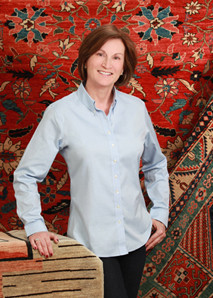 Connie Duckworth, founder & CEO of ARZU
Connie Duckworth, founder & CEO of ARZU
As an early woman partner at Goldman Sachs, Connie Duckworth spent her career carving out a presence for women in the business sector. Undeterred by being the only woman in the room, she enjoyed her career in financial services and worked hard to establish family-friendly policies to ensure that other women could do the same.
To some degree, philanthropy found her. Shortly after she retired from Goldman Sachs she was invited to join the U.S. Department of State’s U.S.-Afghan Women’s Council. She returned from Kabul knowing she “had to do something.” Always a businesswoman, that “something” took the form of a social business called ARZU Studio Hope, which she has been running since 2003.

ARZU Studio Hope sells high-quality Afghan rugs, but that’s just the means to an end. The nonprofit’s real goal is creating jobs for women in a place rife with poverty and discrimination. As one might expect, empowering women in rural Afghanistan requires more than teaching them to weave. Duckworth explains how consistent monitoring and measurement, as well as embracing new and creative approaches, have translated to social impact and increased financial sustainability.
Alison Powell and Alex Goldmark: Tell us a little about ARZU Studio Hope.
Connie Duckworth: From the very beginning, my overarching objective in founding ARZU was to find a way to put as many Afghan women to work as possible in a fair labor setting.
I set it up as a social business. To me, this means that, irrespective of the legal structure, I think about and run ARZU very much like a business. I envisioned a closed loop of funding that was not reliant on traditional charity.
At the outset, I was completely product agnostic. I simply wanted to find the highest-margin, most-reliable, export-quality product. So after a couple of dead ends, we backed into rugs. Ten years ago, I thought it would be a simple equation of putting buyer and seller together; it turned out to have a much longer ramp up to establish a footprint and get quality in place to create a distributed manufacturing environment. We knew we had achieved our first major milestone when an ARZU piece was selected “Best Rug of 2009” by Interior Design magazine.
How do you think about measuring your results? Can you share an example of a time when you changed your strategy based on some of the information you collected?
We track quite a bit of data routinely. For instance, we keep track of not only whom we are paying and how much we’re paying them, but also education and maternal health.
Embedded in our jobs is an education requirement: All children must be in school—girls and boys—and all women must be in adult literacy classes. We also have a maternal health program, so we track the pregnant women, we track the immunizations.
Once a year we sit down and do “life change assessments” where we have a formal list of questions and ask what has changed in our staff members’ lives in the past year. Through these interviews, we discern “What is our next priority?” if we have the funding. We let measurement and data guide new initiatives. That is what led us to the super adobe housing we commissioned…
What is super adobe housing and what did you see in those interviews that led you there?
We’re working in a climate where, in the winter, people freeze to death. There is no heat in the mud brick homes Afghans have. As this bubbled up in our conversations, our attention was drawn to hundreds of families that were squatting in caves. Most of those women living in caves are widows—one of our target groups.
So we piloted a building technique called super adobe. It allows us to make structures that retain heat in the winter and are cooler in the summer. You can build these structures with basically dirt, plastic bags, a little barbed wire, and a special kind of stucco.
This was funded by an anonymous donor, who was so pleased with our test structures that the donor decided to fund a mini-housing development. We’ve completed fifteen homes for families who had no shelter.
But another outcome of the test was a different-style structure—a large vaulted, well-lit, one-story building. Since we had a suitable building, we decided to open a preschool—the first in the province. We now have four preschools. We had no idea we were going into the preschool business, but that was the biggest community need and we had the means, so we filled the gap.
Video: Since we had a sustainable building, we decided to open a preschool.
It sounds like when an opportunity presents itself, you try to seize it. Is that fair to say?
Yes, but let me add a comment. We’re very opportunistic when we are presented with resources, but the practical reality is that there are endless needs going unmet in Afghanistan.
So if we have a donor who’s interested in creating social benefit, typically they ask, “What would you like us to fund?”
We have prioritized the needs through our interaction with the local community, and they are all clustered around education and healthcare. The ideas come from the community, and the donors have been happy with that approach. Our measurement process resulted in a prioritized project list, which attracted donors eager for a specific way to help.
What is another example of an opportunity that came up and how you shifted your strategy to take advantage of it?
Our last piece of the puzzle in ARZU is profitability. By profitability, we mean having enough positive cash flow to cover all costs of production, as well as the costs for the capital projects [like the ones I was discussing earlier]. If we sold about 300 more rugs a year, we would be there. Currently we are selling about 700.
Video: My goal from day one has been to run this as a profitable nonprofit.
Our biggest issue, as a small social business, continues to be how to build our brand in the absence of marketing, PR, and advertising budgets. As I was thinking about how to crack this brand-awareness nut, I got the idea to approach iconic architects. My goal is to drive the ARZU brand through affiliation with these opinion-makers—all well known to our natural buyers like architects and interior designers—who influence the purchase of our products.
We reached out to six internationally famous architects, who generously agreed to design modern patterns and gift them to ARZU. These architects are Frank Gehry, Robert Stern, Zaha Hadid, Stanley Tigerman, and Margaret McCurry. We have introduced the Masters Collection, which features their designs. This project has achieved multiple goals around branding and visibility. When confronted with a persistent challenge—like ours with financial sustainability—you can think “outside the box” and find strategic allies.
This collection has also been our most ambitious artistic endeavor. Every time I look at the rugs in our Master’s Collection and think of the mud brick homes where they were made, it blows my mind.
Support SSIR’s coverage of cross-sector solutions to global challenges.
Help us further the reach of innovative ideas. Donate today.
Read more stories by Alex Goldmark & Alison Powell.

